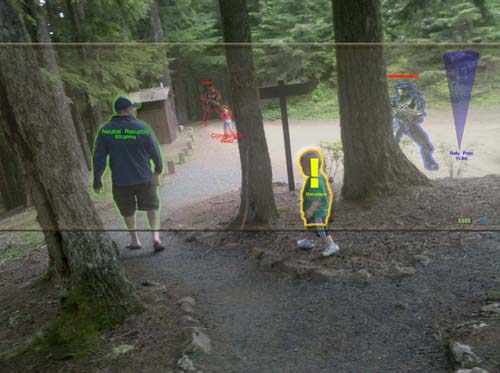 |
|||||||||||||
|
Anna Bancroft, Adaptive Gaming, 4/9/2012Problem StatementObesity in America is reaching ever-higher numbers every year while video games, especially those related to social networking sites like Facebook, continue to increase in popularity. The goal of this project is to design hardware and a user interface which allows a user to interact with a virtual game world by physical movement. Integration with social networking, cell phones, and internet browsers would enhance this project. Spin-offs include physical therapy and monitored child play-pens. Initial Concept
The first concept for this project was a physical gaming sphere with several wireless IR sensors placed in it. It was set on a base that allowed free rotation and used a sliding door mechanism. For full use, It would require the additional application of a VR headset and specialized hand and finger grips. A significant amount of concept work was completed on the first design including theoretical grip design and a short, rough concept video. More information on the initial design for this project, including the concept video, can be found here. This approach was discontinued after the discovery that a similar, lower-tech version of this has been on the market for several years. Information on one of the existing products can be found at virtusphere.com. Heads-upSince the first inception, this project has evolved, with the collaboration of John Korbin, into a multi-dimensional environmentally adaptive gaming interface. Because of the new variability, several concepts are being toyed with including, as discussed in class, locative gaming and location-specific podcasts (a project by Jennifer Piarowski). As such, there are necessarily several parts to the new development. HardwareThe needs of the project require a complicated, adaptive interface that incorporates auditory, visual, and potentially tactile senses. Obviously for a gaming system of this type, body location and position must somehow be sensed and should be the primary way to interact with the game system. Additionally, the hardware will need a method to recognize local environmental obstacles and hazards. An exchangable software input is needed, be it disc-based or wireless. Processing and computing will take up significant space; however, the bulkiest part of the system, in theory, will be the power source.
Visual interface
The visual interface is a necessarily very versatile portion of the project. The hardware will need to be light enough to be worn on the head, easily see-through, provide a sense of 3D placement and have high enough contrast to make objects well-visible. To facilitate the 3D nature of the game interaction, the headset will be composed of two screens, or lenses, much like a standard pair of glasses. The same general images will be displayed on both sides, with object placement giving the sense of distance and rotation in the outside world. The material for the lenses, at this point in time, is transparent OLED screens*. Depending on the resolution of this display, the headset may have to sit slightly farther away from the face than standard glasses. Google® plans to release a pair of glasses this year that may be adapted to this project. SoftwareThis is intended as, foremost, a gaming system; however, with appropriate software it could be very versatile. In class we have discussed locative art and podcasts that could be integrated into a system like this with a wi-fi or 3G connection. The Epic WinReferencesGeneral
Shape Memory Alloy
Vision and Sensory
Videos |
